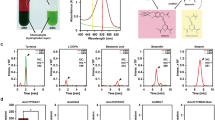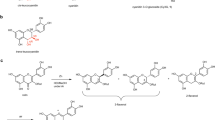Abstract
THE interesting communication of R. G. Peterson and M. A. Joslyn on this subject calls for some comment. In the first place, the term “nitrogenous anthocyanin” is used partly chemically (nitrogenous) and largely botanically (anthocyanin) to denote an obviously related group of water-soluble bluish-red colouring matters, such as those of Beta, Atriplex, Celosia, and certain Cactaceae. The only evidence favouring some form of amino-flavylium salt structure, which was the basis of a working hypothesis, was the colour and some other properties of synthetic amino-flavylium salts containing hydroxyl and methoxyl groups1. There was a certain resemblance between the absorption spectra in the visible region of betanin and 4′-amino-3 : 7-dihydroxyflavylium chloride. However, no phenolic degradation products could be obtained from betanidin2. We have always recognized that the relation to the flavylium group was unconfirmed and a purely speculative hypothesis. The evidence in favour of a pyrroloid constitution is not much stronger.
This is a preview of subscription content, access via your institution
Access options
Subscribe to this journal
Receive 51 print issues and online access
$199.00 per year
only $3.90 per issue
Buy this article
- Purchase on SpringerLink
- Instant access to full article PDF
Prices may be subject to local taxes which are calculated during checkout
Similar content being viewed by others
References
Robinson, A. M., and Robinson, R., J. Chem. Soc., 1439 (1932).
Ainley, A. D., and Robinson, R., J. Chem. Soc., 446 (1937).
Price, J. R., and Robinson, R., J. Chem. Soc., 449 (1937).
Author information
Authors and Affiliations
Rights and permissions
About this article
Cite this article
ROBINSON, R. Nature of Betanin, the Pigment of Red Beet. Nature 182, 46 (1958). https://doi.org/10.1038/182046a0
Issue date:
DOI: https://doi.org/10.1038/182046a0



